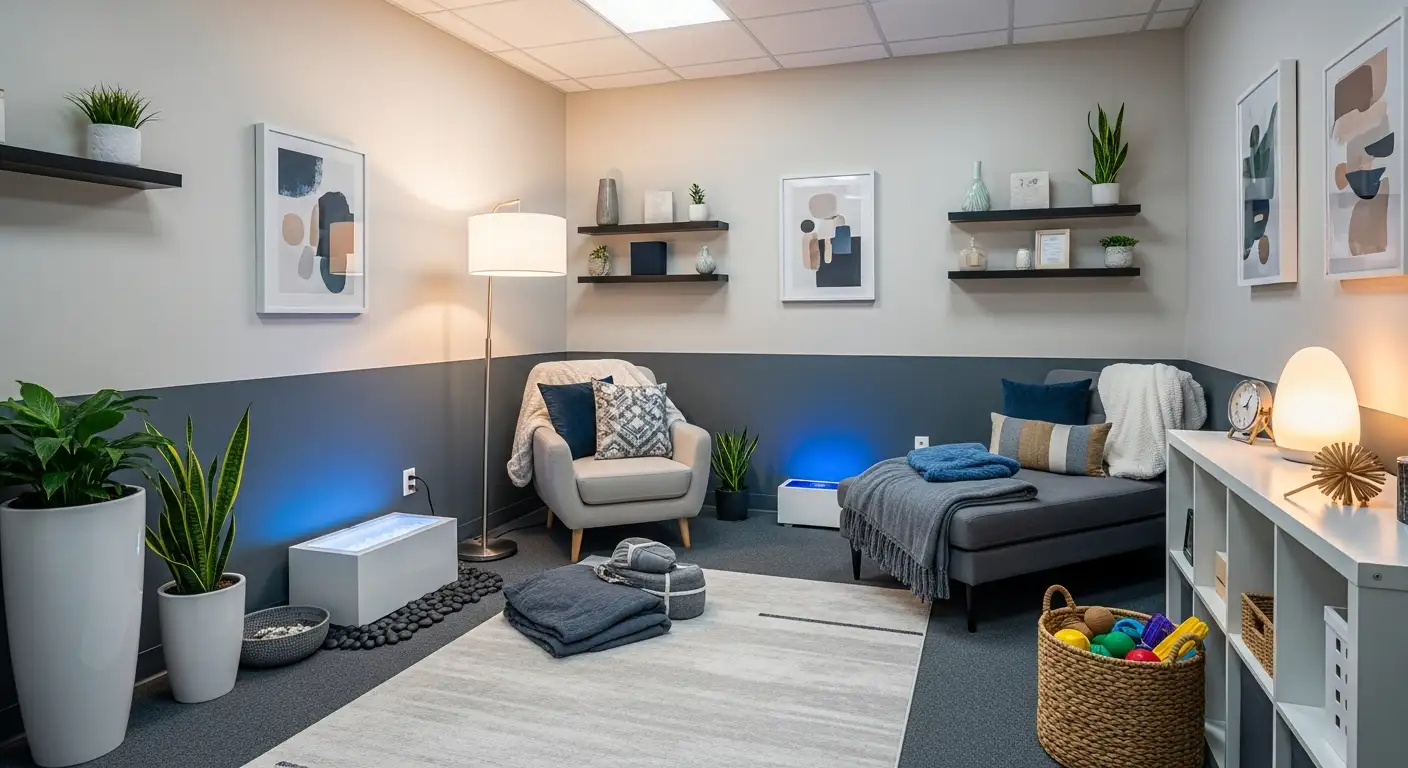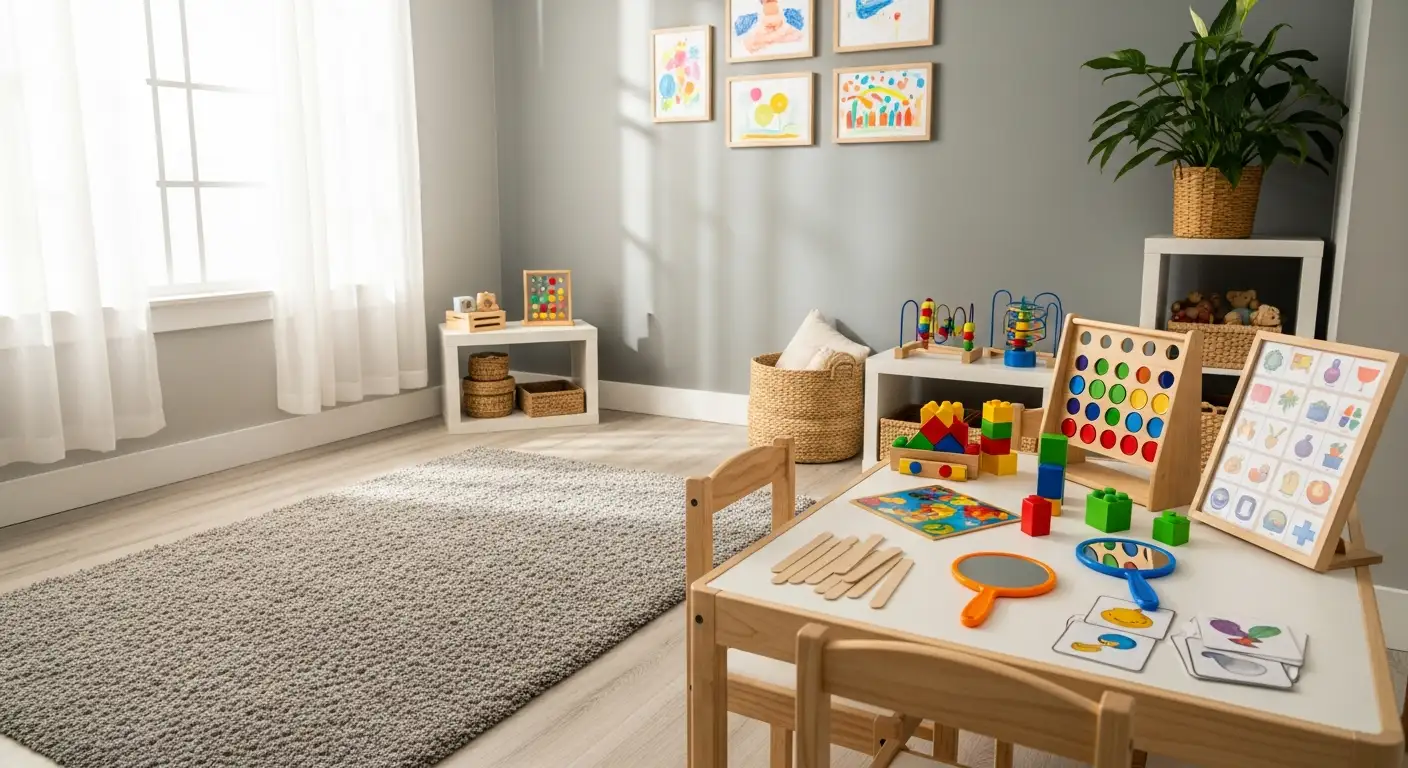Preparing for Your Child’s First Therapy Session
Initiating therapy for your child is a significant step towards supporting their emotional and developmental well-being. While it can feel overwhelming, understanding what to expect and how to prepare can help make the first session a positive experience for both you and your child. This guide outlines the essentials of what happens during the initial visit, how to set the stage for success, and ways to support your child's journey.
What Happens During Your Child’s First Therapy Session

Introduction of the therapist and setting a welcoming environment
The first therapy session for a child begins with the therapist introducing themselves in a friendly, approachable manner. Creating a warm and inviting space is crucial to help the child feel safe and comfortable. Often, therapists use play-based activities or art to establish a relaxed atmosphere, especially for younger children who communicate best through play rather than words.
Building rapport with the child through engaging activities like play or art
Therapists aim to build a trusting relationship by engaging the child with activities suited to their developmental stage. For young children, this might include drawing, storytelling, or playing with toys. These activities allow children to express their feelings indirectly and help the therapist observe their behavior, communication style, and emotional responses.
Discussion of the child’s background, concerns, and goals
A key part of the initial session involves gathering information about the child's history, including developmental milestones, previous issues, and recent stressors. Parents are often asked to share their concerns, specific behaviors, and what they hope to achieve through therapy. This collaborative discussion helps set clear, achievable goals tailored to the child's needs.
Completion of paperwork including consent forms and treatment plans
Parents usually fill out consent forms and questionnaires that outline confidentiality limits, the framework of therapy, session frequency, and payment details. This administrative step ensures everyone understands the process and legal considerations.
Exploration of feelings and experiences to assess needs
The therapist gently explores the child's feelings, thoughts, and experiences through open-ended questions and activities. For example, a therapist might ask about how the child feels at school or home, or discuss recent events to understand their emotional state better.
Establishing confidentiality and explaining the therapy process
A vital part of the first session is explaining confidentiality—what information remains private and when disclosures are required by law (such as if there is a risk of harm). The therapist will also explain what the child can expect from future sessions, including activities, possible milestones, and how progress will be measured.
This initial meeting lays a strong foundation, helping both child and parent feel at ease while providing the therapist vital insights to craft an effective treatment plan. Building trust and understanding in this first session encourages ongoing participation and sets the stage for meaningful progress.
How to Prepare Your Child for the First Therapy Session

How can parents prepare their child for therapy to reduce anxiety?
Preparing your child for their first therapy session is an important step in ensuring they feel safe, supported, and ready to engage. Clear, honest communication tailored to your child's age and understanding is essential. Use simple and developmentally appropriate language to explain what therapy is, emphasizing that it’s a safe and supportive environment where they can share their feelings, thoughts, and worries.
Normalizing therapy by sharing that many people benefit from it—including celebrities and athletes—can help reduce any stigma or embarrassment your child might feel. This comparison makes therapy seem like a routine part of taking care of health, much like visiting a doctor or dentist.
Choose a calm, relaxed moment for discussing therapy, such as during a walk or bedtime, when your child is most receptive. Including your child in conversations about what to expect helps them feel involved and builds trust. Explain that the therapist will listen, play, or chat, depending on their age, and that nothing they share will be told to others.
Reassure your child about confidentiality, clarifying that what they say in therapy stays private unless it involves safety concerns. Reinforcing that therapy is a positive, supportive process aimed at helping them feel better can significantly reduce feelings of fear or resistance.
Often, visiting the therapy location beforehand can make the environment familiar and less intimidating. If possible, take a tour of the center, meet the therapist briefly, and show your child the space where they will attend their sessions.
Finally, gather relevant documents such as reports, medical records, or past evaluations, which will help the therapist understand your child's needs from the start. Being well-prepared can make the first appointment smoother and more effective.
Supporting your child with patience, understanding, and positive reinforcement encourages a successful beginning to therapy, setting the stage for progress and growth.
Communicating with Your Child About Therapy
 Introducing therapy to a child can feel overwhelming for both parents and the young person. The way you discuss it can significantly influence how comfortable and open they feel about the process. Using age-appropriate language is essential. For young children aged 4 to 7, describing therapy as a 'feelings doctor' or 'talking time' helps them grasp the idea in a gentle, reassuring way. For teenagers, providing a straightforward explanation of the benefits, such as improving communication or coping skills, can foster clarity and reduce apprehension.
Introducing therapy to a child can feel overwhelming for both parents and the young person. The way you discuss it can significantly influence how comfortable and open they feel about the process. Using age-appropriate language is essential. For young children aged 4 to 7, describing therapy as a 'feelings doctor' or 'talking time' helps them grasp the idea in a gentle, reassuring way. For teenagers, providing a straightforward explanation of the benefits, such as improving communication or coping skills, can foster clarity and reduce apprehension.
Reassurance about privacy and safety is crucial. Emphasize that therapy is a private space where they are not forced to share anything before they are ready. Making it clear that their thoughts and feelings are respected and confidential helps build trust. It's also helpful to normalize the experience by sharing positive stories or noting that many children, even some celebrities or athletes, benefit from therapy. Comparing therapy to routine health check-ups like visiting a doctor or dentist can reduce stigma and make it seem like a normal part of caring for oneself.
Encouraging an open dialogue is equally important. Invite your child to ask questions and express their feelings about starting therapy. When they do, listen patiently and respond honestly, tailoring your explanations to their developmental level. Highlight that therapy is purely supportive—helping them learn skills to feel better and manage emotions. Reassure them that they are not alone and that many find therapy helpful.
It's natural for children to feel anxious or unsure. Patience and honesty are vital. If they are resistant or express fears, acknowledge those feelings without dismissing them. Respect their emotional responses and reassure them that they can take their time. Maintaining a calm, positive attitude and providing ongoing support reinforces trust.
In summary, clear, compassionate communication can ease the therapy process. Cultivating an environment where your child feels safe, supported, and heard encourages participation and maximizes the benefits of therapy. Remember, the goal is to make your child see therapy as a helpful and caring experience—an opportunity for growth, learning, and feeling supported in their emotional journey.
The Different Types and Formats of Therapy for Children

What are the common formats and types of therapy used in initial sessions?
In the early stages of therapy for children, several formats are available to best meet their needs and comfort levels. These include individual therapy where the child works one-on-one with a therapist, family therapy involving the entire family to improve communication and relationships, group therapy with peers facing similar issues, and sometimes couples therapy if appropriate.
The initial session, often called an intake, involves gathering important background information about the child's development, experiences, and current concerns. This helps the therapist understand the child's unique situation and build a tailored treatment plan.
During this assessment, the therapist explores the child's emotional, behavioral, and social functioning through questions and observations. They may also introduce various therapeutic approaches, such as cognitive-behavioral therapy (CBT), which focuses on changing negative thoughts and habits; psychodynamic therapy, which explores underlying emotional issues; humanistic therapy, emphasizing personal growth; or supportive therapy, providing reassurance and coping strategies.
A key part of the first appointment is discussing the structure of therapy—how many sessions are likely needed, their frequency, and the goals participants aim to achieve. This conversation ensures everyone is clear about what to expect and can collaborate effectively.
In addition, if therapy involves telehealth, the process includes signing informed consent forms and completing questionnaires to facilitate effective remote sessions. The initial appointment establishes the foundation for ongoing treatment, emphasizing clarity, comfort, and shared goals.
Popular approaches such as play therapy, cognitive-behavioral therapy (CBT), art therapy, and family therapy
Different therapies appeal to different age groups and issues. Play therapy is especially suitable for young children, allowing them to express feelings through play, storytelling, and art, which are natural communication methods at this stage.
Cognitive-behavioral therapy (CBT) is effective across ages, helping children identify and modify negative thoughts and behavior patterns while teaching healthy coping skills.
Art therapy uses creative activities like drawing, painting, or sculpting to enable children to communicate emotions that they might find difficult to express verbally.
Family therapy involves parents and sometimes siblings, addressing family dynamics, communication, and conflict resolution to support the child's wellbeing.
Other approaches include neurodevelopmental techniques, sensory integration activities, and social skills training, all tailored to suit the child's developmental stage and individual needs.
How initial sessions typically involve intake, assessment, and goal setting
The first few sessions serve as an evaluation period where the therapist and family establish rapport and trust. During intake, the therapist reviews medical history, developmental background, and current challenges.
Assessment involves observing the child's play, communication, and emotional responses. This helps identify strengths as well as areas needing support.
Based on gathered information, the therapist collaborates with parents and the child to set clear, measurable treatment goals. These goals can target emotional regulation, social skills, academic performance, or specific issues such as anxiety or trauma.
The therapist explains what therapy will involve, discusses session frequency, planned approaches, and expected outcomes. Open communication allows parents and children to express questions and concerns, fostering a partnership.
The importance of clarity about the structure, duration, and treatment goals
Effective therapy depends on families understanding the treatment framework. Clarifying session length (usually 45-60 minutes), frequency (often weekly), and approximate duration helps set expectations.
Discussing goals—such as reducing anxiety, improving social interactions, or managing disruptive behaviors—aligns efforts and measures progress.
The therapist and family agree on how progress will be tracked, whether through questionnaires, behavioral observations, or parent reports.
Having a transparent plan encourages commitment and motivates children to engage actively in their own growth.
Use of engaging, age-appropriate activities during sessions like games, art, storytelling, and play evolving from the child's developmental stage
Children learn best when activities are fun and suited to their age. In therapy, play-based methods are common for young children, allowing them to express feelings and practice skills in a natural way.
Therapists often incorporate games, storytelling, drawing, or role-playing tailored to the child's developmental stage.
For toddlers and preschoolers, play therapy with toys, art activities, or sensory play helps children open up and communicate without words.
Older children and teens might participate in more structured activities like storytelling, journaling, or social skills exercises, which foster self-awareness and emotional regulation.
Using engaging activities not only makes therapy sessions enjoyable but also facilitates meaningful insights, helping children feel safe and understood.
| Format | Typical Use Case | Features | Additional Notes |
|---|---|---|---|
| Individual Therapy | Focused on specific emotional or behavioral issues | Personal attention, tailored strategies | Suitable for many issues, including anxiety and depression |
| Family Therapy | Addressing family dynamics | Whole-family involvement, improving communication | Useful for relationship conflicts or support |
| Group Therapy | Peer support, social skills development | Shared experiences, peer interaction | Often used for social anxiety, grief, or behavioral issues |
| Couples Therapy | Improving communication between partners | Relationship focus, conflict resolution | Less common for children but relevant for teen couples |
Therapies are adapted to each child's age and needs, ensuring engaging, supportive, and effective treatment.
Questions to Ask Your Child's Therapist During the Initial Visits

What questions should I ask the therapist during initial visits?
Starting therapy for your child can feel overwhelming, but asking the right questions during the first few visits can help you feel more confident and ensure the process meets your family's needs.
One of the first things to ask is about the therapist's experience working with children who have similar concerns. For instance, if your child struggles with anxiety, depression, or behavioral issues, it's helpful to know whether the therapist has specific expertise in those areas. This insight can reassure you that they understand your child's unique situation.
Equally important is understanding the therapeutic approach and techniques used by the therapist. You might inquire whether they use methods like Cognitive-Behavioral Therapy (CBT), art therapy, play therapy, or family therapy. Knowing the approach helps you gauge if it aligns with your child's age, preferences, and needs.
Support and progress monitoring are vital aspects of effective therapy. Ask how the therapist plans to support your child throughout treatment and how they will keep track of progress. Do they use assessments, progress notes, or goal-setting strategies? Clarify how often you will receive updates and whether your involvement is part of the process.
It's also beneficial to understand how progress is measured and communicated. Questions like, 'What signs indicate my child is improving?' or 'How do you adjust treatment if progress stalls?' can help set realistic expectations.
Logistical details are equally important. Ask about session frequency—whether weekly or bi-weekly—and how confidentiality works, especially concerning parental involvement. Find out if parents are included in sessions or if updates are provided separately. Clear communication about these logistics builds trust and transparency.
Finally, consider asking open-ended questions such as, 'What can I expect during our sessions?' or 'How long might my child need therapy?' These help you understand the process and give you a clearer picture of how the journey will unfold.
Taking the time to prepare these questions can make your initial visits more productive, ultimately supporting your child's growth and well-being through a collaborative and informed therapeutic relationship.
Supporting Your Child Through the Therapy Process
 Creating a supportive and encouraging environment at home is essential for helping your child feel comfortable and motivated during therapy. Start by explaining therapy in simple, positive language tailored to your child's age. For young children, describing therapy as a 'feelings doctor' or 'talking time' can make the process feel less intimidating. Emphasize that therapy is a safe place where they can share their feelings with a trusted person without being forced.
Creating a supportive and encouraging environment at home is essential for helping your child feel comfortable and motivated during therapy. Start by explaining therapy in simple, positive language tailored to your child's age. For young children, describing therapy as a 'feelings doctor' or 'talking time' can make the process feel less intimidating. Emphasize that therapy is a safe place where they can share their feelings with a trusted person without being forced.
Engaging in activities that reinforce what your child learns in therapy can accelerate progress. Examples include practicing emotions recognition through games, engaging in breathing exercises to manage stress, or role-playing social skills. These activities help your child apply new coping strategies in real-life situations, making therapy benefits more tangible.
Maintaining open lines of communication about feelings and progress is vital. Listen actively to your child's concerns and feelings, validating their emotions without pressuring them to share specifics they might not be ready to discuss. Respect their boundaries and privacy, especially regarding sensitive topics or confidential information shared during therapy. Keep conversations age-appropriate and encourage them to ask questions, fostering a sense of trust and openness.
Progress in therapy can sometimes be slow or zigzag, but patience is crucial. Celebrate small victories, like expressing a new emotion or using a coping skill effectively. Recognize their efforts and resilience to boost confidence and motivation.
Support from parents extends beyond words and activities. Your involvement includes collaborating with your child's therapist, following recommended strategies, and providing a stable, calm environment. This coordination ensures consistency and reinforces the skills your child is developing in therapy.
To sum up, your positive attitude, patience, and active participation can significantly influence your child's therapeutic experience. By being a strong supporter and advocate, you help your child navigate their emotional growth and develop healthier coping mechanisms that will serve them throughout life.
Tracking Progress and Recognizing When to Seek Additional Help

How do I track my child's progress and understand the outcomes of therapy sessions?
Monitoring your child's development during therapy is essential for understanding how well the treatment is working and whether adjustments are needed. Regular updates from the therapist are a primary resource — they can provide insights into your child's growth, milestones, and areas that may need further attention.
One effective way to track progress is by using practical tools like journals or goal charts. These tools help record daily or weekly observations, specific behaviors, and emotional responses. For example, a goal chart might set targets such as improved communication, better emotional regulation, or reduction in specific anxieties. Visual progress charts, such as stickers or graphs, make it easy for both you and your child to see how far they've come.
Encouraging your child to participate in the monitoring process can be motivating. Ask them how they feel about their progress and what changes they have noticed. Self-assessment stickers or simple questionnaires can empower children to express their feelings about therapy and recognize their own achievements.
Consistency in communication is vital. Arrange regular check-ins with the therapist to discuss progress. Some clinics offer progress reviews every few months, during which therapists evaluate whether the current approach is effective or if modifications are necessary. These sessions are also opportunities to set new goals or adjust existing ones.
Incorporating diverse methods like digital dashboards or apps designed for therapy progress can make tracking more engaging for children. These tools often include interactive elements like quizzes, mood charts, or progress badges, which can motivate children and help keep parents informed.
Finally, stay vigilant for behavioral, emotional, and social signs as indicators of progress. Improvement might show in better peer interactions, increased emotional resilience, or greater adaptability in new settings. Conversely, persistent or escalating signs of emotional distress, such as withdrawal, aggression, or anxiety, should prompt a re-evaluation of the current treatment plan.
Keeping an open dialogue with your child's therapist, using structured tools, and observing your child's overall functioning collectively provide a comprehensive picture of their therapy journey. This proactive approach ensures that your child receives ongoing support tailored to their evolving needs.
Continuing Support and Maintaining Progress
Starting therapy is a valuable step toward helping your child develop resilience, emotional intelligence, and coping skills. The initial session lays the groundwork for future success, emphasizing the importance of open communication, supportive involvement, and regular progress evaluations. Remember that therapy is a personalized journey, and just like in any new experience, patience and positivity are key. By maintaining a supportive home environment and collaborating with your child's therapist, you can help foster growth and ensure that the benefits of therapy extend well beyond the first visit.
References
- How to Prepare Your Child for Therapy: Tips for Parents
- Preparing for Your Child's First Appointment - Child Mind Institute
- What to Expect in the First Therapy Session for Kids and Teens
- What Should I Bring to My Child's First Appointment?
- What to Expect When Your Child Goes to Therapy: A Parents' Guide
- Taking Your Child to a Therapist | Nemours KidsHealth
- What to expect at your child's first counseling session : Clients






